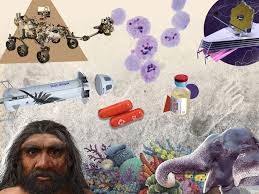Recent Major Scientific Discoveries
Science continues to push the boundaries of human knowledge, with researchers around the world making groundbreaking discoveries that shape our understanding of the universe. Here are some of the recent major scientific breakthroughs:
Gravitational Waves Detection
In 2015, scientists confirmed the existence of gravitational waves, ripples in spacetime predicted by Albert Einstein’s theory of general relativity a century earlier. This discovery opened up a new era of astronomy, allowing us to observe cosmic events such as black hole mergers.
CRISPR Gene Editing
The development of CRISPR-Cas9 technology revolutionised genetic engineering, enabling precise and efficient editing of DNA sequences. This breakthrough has vast implications for healthcare, agriculture, and environmental conservation.
Quantum Supremacy
In 2019, Google claimed to have achieved quantum supremacy by demonstrating a quantum computer’s ability to solve a complex problem faster than a classical supercomputer. This milestone paves the way for quantum computing’s potential to revolutionise computation.
Mars Perseverance Rover
NASA’s Perseverance Rover successfully landed on Mars in February 2021, equipped with advanced scientific instruments to search for signs of past microbial life and collect samples for future return to Earth. This mission represents a significant step towards understanding the Red Planet’s history.
COVID-19 Vaccines
The rapid development and deployment of multiple COVID-19 vaccines in response to the global pandemic showcased the power of collaboration and innovation in science. These vaccines offer hope for controlling the spread of the virus and returning to normalcy.
These recent scientific discoveries highlight humanity’s relentless pursuit of knowledge and advancement. As researchers continue to push boundaries and explore new frontiers, we can expect more exciting breakthroughs that shape our future.
Unveiling the Unknown: Recent Breakthroughs in Human Anatomy, Cosmic Phenomena, and Genetic Research
- Scientists have discovered a new organ in the human body called the interstitium, which could potentially impact our understanding of diseases.
- Astronomers have detected the first ever fast radio burst that repeats at regular intervals, shedding light on these mysterious cosmic phenomena.
- Researchers have found evidence suggesting that there may be a parallel universe where time runs backwards.
- A new study has revealed that microplastics are present in human organs for the first time, highlighting the extent of plastic pollution’s impact on health.
- Scientists have developed a CRISPR-based tool that can detect specific targets in cells with high accuracy, revolutionising genetic research and diagnostics.
Scientists have discovered a new organ in the human body called the interstitium, which could potentially impact our understanding of diseases.
Scientists have recently made a significant discovery by identifying a new organ in the human body known as the interstitium. This finding has the potential to revolutionise our understanding of diseases and medical conditions. The interstitium, previously thought to be simply layers of connective tissue, is now recognised as a complex network of fluid-filled spaces throughout the body. This newfound organ could play a crucial role in how diseases spread and develop, leading to groundbreaking insights that may pave the way for innovative treatments and therapies in the future.
Astronomers have detected the first ever fast radio burst that repeats at regular intervals, shedding light on these mysterious cosmic phenomena.
Astronomers have recently made a significant breakthrough by detecting the first-ever fast radio burst that repeats at regular intervals. This discovery has provided valuable insights into the enigmatic nature of these cosmic phenomena, shedding light on their mysterious origins and behaviour. By studying these repeating fast radio bursts, scientists are poised to unravel more secrets of the universe and deepen our understanding of the cosmic events that shape the fabric of space and time.
Researchers have found evidence suggesting that there may be a parallel universe where time runs backwards.
Researchers have recently uncovered intriguing evidence hinting at the existence of a parallel universe where time may flow in reverse. This mind-boggling discovery challenges our conventional understanding of the cosmos and opens up a realm of possibilities that stretch the limits of our imagination. The notion of a parallel universe with reversed time raises profound questions about the nature of reality and the mysteries that lie beyond our current comprehension. Scientists are delving deeper into this enigmatic phenomenon, sparking curiosity and fascination among both experts and enthusiasts alike.
A new study has revealed that microplastics are present in human organs for the first time, highlighting the extent of plastic pollution’s impact on health.
A recent groundbreaking study has unveiled a startling discovery – microplastics have been found in human organs for the first time. This revelation sheds light on the pervasive presence of plastic pollution in our environment and its alarming impact on human health. The fact that these tiny plastic particles have made their way into our bodies underscores the urgent need to address and mitigate the detrimental effects of plastic waste on both ecosystems and human well-being. This finding serves as a stark reminder of the interconnectedness between environmental sustainability and public health, urging us to take decisive action to combat plastic pollution for a healthier future.
Scientists have developed a CRISPR-based tool that can detect specific targets in cells with high accuracy, revolutionising genetic research and diagnostics.
In a significant stride for genetic research and diagnostics, scientists have unveiled a groundbreaking CRISPR-based tool capable of pinpointing specific targets within cells with remarkable precision. This innovative technology represents a paradigm shift in the field, offering unprecedented accuracy in identifying genetic sequences and opening new avenues for understanding and manipulating the building blocks of life. The advent of this tool heralds a new era in genetic research, promising to revolutionise how we diagnose and treat diseases by providing a powerful and versatile tool for exploring the intricacies of the genome.

